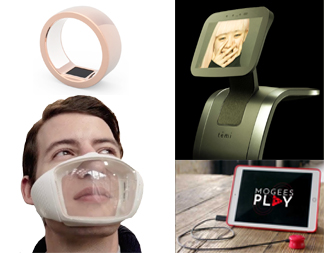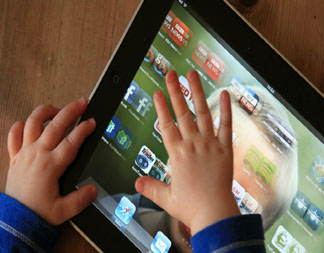The latest technology has had a significant impact on our lives in many ways, some of which include-
Increased connectivity: Latest technology, such as smartphones and social media, has enabled us to stay connected with friends, family, and colleagues from anywhere in the world. This has improved communication and collaboration, both in personal and professional settings.
Access to information: The latest technology has made it easier for people to access information on various topics. The internet, for example, provides instant access to a vast amount of information that was not available in the past.
Automation: The latest technology has enabled automation of many tasks that were previously done manually. This has led to increased efficiency and productivity in many industries.
Improved healthcare: Latest technology has made healthcare more accessible and efficient. Telemedicine, for example, allows doctors to diagnose and treat patients remotely, which can save time and money for patients and healthcare providers.
Entertainment: The latest technology has transformed the way we consume entertainment. Streaming services, for example, have made it easier for people to access movies and TV shows on demand.
Environmental impact: The latest technology has also had an impact on the environment. Advancements in renewable energy technology, for example, have made it possible to generate clean energy from sources such as wind and solar power.
Overall, the latest technology has had a profound impact on our lives, making it easier, more convenient, and more efficient in many ways. However, it also presents new challenges and ethical considerations that must be addressed as we continue to develop and integrate new technologies into our lives.
Listed Below Are the Top New Technology Trends, 2023
Listed Below Are The Top New Technology Trends in 2023
1. Robotic Process Automation (RPA)
2. Edge Computing
3. Quantum Computing
4. Virtual Reality and Augmented Reality
5. Blockchain
6. Internet of Things (IoT)
7. 5G
8. Cyber Security
1. Robotic Process Automation (RPA)
Robotic Process Automation (RPA) is a type of automation technology that uses software robots or “bots” to automate repetitive and routine tasks that are typically performed by humans. RPA is designed to mimic human interactions with digital systems and applications to perform tasks such as data entry, data extraction, and data processing.
RPA bots are programmed to follow predefined rules and instructions, and they can be trained to perform a wide range of tasks. They can also be integrated with other systems and applications, such as ERP systems, CRM systems, and web applications, to automate end-to-end business processes.
RPA is different from traditional automation technologies because it can be implemented quickly and does not require extensive programming skills. RPA bots can be configured through a user-friendly interface, and they can learn from human operators to improve their performance over time.
RPA has many benefits, including increased efficiency, accuracy, and cost savings. It can also free up human workers from repetitive and mundane tasks, allowing them to focus on more complex and strategic work. RPA is being used in many industries, including finance, healthcare, manufacturing, and logistics, to automate business processes and improve operational efficiency.
2. Edge Computing
Edge computing is a distributed computing paradigm that brings computation and data storage closer to the location where it is needed, in order to improve the performance and efficiency of data processing. Edge computing aims to reduce the latency and bandwidth requirements of cloud computing by processing data at or near the edge of the network, where the data is generated or consumed.
In edge computing, data processing and storage are done on local devices, such as smartphones, IoT devices, and network routers, rather than in a central location such as a cloud data center. This allows for faster response times and reduces the need for data to be sent back and forth between the device and the cloud, which can be particularly useful in applications that require real-time processing, such as autonomous vehicles, drones, and augmented reality.
Edge computing also offers other benefits, such as improved security, as data is processed locally rather than being sent over the network, and reduced network congestion, as less data is sent over the network. Additionally, edge computing can reduce the cost of cloud computing, as less data needs to be processed in the cloud, and can provide better privacy for users, as data is not stored on central servers.
Edge computing is being used in a variety of applications, such as smart cities, industrial IoT, and healthcare, where real-time data processing and low latency are critical. As more devices become connected to the internet, the demand for edge computing is expected to increase, driving further innovation in this field.
3. Quantum Computing
Quantum computing is an emerging field of computing that uses quantum-mechanical phenomena, such as superposition and entanglement, to perform operations on data. It is fundamentally different from classical computing, which relies on binary digits (bits) that can be either 0 or 1.
Quantum computers use quantum bits (qubits) that can be in a superposition of both 0 and 1 states at the same time, allowing for much faster processing and more complex calculations than classical computers. Quantum computing can solve certain types of problems exponentially faster than classical computers, such as factoring large numbers and simulating complex systems.
Quantum computing has many potential applications in areas such as cryptography, machine learning, drug discovery, and optimization. For example, quantum computers could break current encryption methods used to protect sensitive information, leading to the development of new quantum-resistant cryptographic algorithms. They could also accelerate the discovery of new drugs by simulating the behavior of molecules and proteins more accurately than classical computers.
However, quantum computing is still in its early stages, and many technical challenges must be overcome before it can become a practical technology. One of the main challenges is the issue of quantum decoherence, which causes qubits to lose their quantum state and become classical bits. There are also significant challenges in building and scaling up quantum hardware, developing software and algorithms that can run on quantum computers, and integrating quantum computing into existing computing infrastructure.
Despite these challenges, there has been significant progress in quantum computing in recent years, and the technology is expected to have a major impact on a wide range of industries in the future.
4. Virtual Reality and Augmented Reality
Virtual Reality (VR) and Augmented Reality (AR) are two related technologies that create immersive and interactive experiences for users.
Virtual Reality (VR) is a computer-generated simulation of a 3D environment that users can interact with using a headset and sometimes controllers. The user’s movement and actions are tracked by sensors, and the VR system adjusts the simulation accordingly to create a sense of presence in a virtual world. Users can move around and interact with objects in the virtual environment, which can be designed to simulate real-world scenarios or entirely fictional ones.
Augmented Reality (AR), on the other hand, overlays digital content onto the real world. AR is typically experienced through a mobile device or a headset that uses cameras and sensors to track the user’s surroundings and position. The digital content is then overlaid onto the real world in a way that appears to be part of the user’s environment. This can include information, images, or 3D objects that are superimposed onto the real world.
Both VR and AR have numerous applications in a variety of industries, including entertainment, education, healthcare, and manufacturing. For example, VR can be used for immersive gaming experiences, virtual training simulations for employees, or therapeutic treatments for mental health conditions. AR can be used for mobile gaming experiences, providing contextual information in real-time, or visualizing how a product would look in a real-world environment before making a purchase.
As technology continues to advance, VR and AR are expected to become more realistic and widespread, creating new possibilities for how we interact with digital content and the world around us.
5. Blockchain
Blockchain is a digital ledger technology that enables secure and decentralized transactions. It consists of a distributed database that records transactions in a secure and immutable way, using cryptography to ensure the integrity and authenticity of the data.
Blockchain technology has the potential to transform the economy in several ways. One of the most significant impacts is on the financial industry, where blockchain is being used to create new financial instruments, such as cryptocurrencies and digital tokens. Cryptocurrencies, such as Bitcoin and Ethereum, are decentralized digital currencies that use blockchain technology to securely record transactions and store value. They offer a new way to conduct financial transactions without relying on traditional financial institutions, such as banks.
Blockchain technology can also increase the efficiency and transparency of financial transactions by reducing the need for intermediaries and middlemen. This can lower transaction costs, reduce the time it takes to settle transactions, and eliminate the risk of fraud or manipulation.
Blockchain is a decentralized digital ledger technology that allows transactions to be recorded and verified without the need for a central authority or intermediary. It is a distributed database that maintains a continuously growing list of records called “blocks,” which are linked and secured using cryptography.
Each block in the chain contains a unique cryptographic hash that is generated based on the contents of the previous block, along with new transactions that are added to the current block. This ensures that the data in each block is immutable, meaning it cannot be altered once it has been recorded.
Blockchain technology enables secure and transparent transactions, as all participants in the network have access to the same information and can validate the authenticity of transactions. It has been used for a variety of applications, including cryptocurrency, supply chain management, and digital identity verification.
6. Internet of Things (IoT)
The Internet of Things (IoT) refers to a network of physical objects, devices, vehicles, buildings, and other items that are embedded with sensors, software, and connectivity, which allows them to connect and exchange data with other devices and systems over the internet.
IoT devices can collect and transmit data such as temperature, humidity, location, and other environmental conditions. This data can be analyzed and used to monitor and control the behavior of connected devices, improve efficiency, and enhance decision-making processes.
IoT technology is being used in a variety of industries, including healthcare, manufacturing, transportation, and agriculture, to create new products and services and optimize existing processes. For example, in healthcare, IoT devices can be used to monitor patient health and provide real-time alerts to healthcare professionals, while in manufacturing, IoT sensors can help optimize production processes and reduce waste.
7. 5G
5G (fifth generation) is the latest wireless network technology that is designed to provide faster data transfer rates, lower latency, and increased network capacity compared to previous generations of cellular networks such as 4G LTE. 5G networks are expected to support a large number of connected devices, enable high-speed internet access, and drive innovation in emerging technologies such as autonomous vehicles, virtual reality, and the Internet of Things (IoT).
5G networks use a combination of different technologies, including higher frequency bands, advanced antenna technologies, and network slicing. Higher frequency bands, such as millimeter waves, offer faster data transfer rates but have shorter ranges and require more infrastructure. Advanced antenna technologies, such as beamforming and massive MIMO, enable more efficient use of spectrum and better coverage. Network slicing allows different parts of the network to be optimized for specific use cases, such as low latency for autonomous vehicles or high bandwidth for video streaming.
The rollout of 5G networks has been ongoing, with many countries and telecommunication companies investing in infrastructure and devices that support 5G. As 5G networks continue to expand and mature, it is expected to enable new and innovative applications and services that were not possible with previous generations of wireless networks.
8. Cyber Security
Cybersecurity refers to the practices, technologies, and measures used to protect computer systems, networks, and data from unauthorized access, theft, damage, or other types of cyber threats. It involves the protection of computer systems, networks, and other electronic devices from theft, damage or unauthorized access.
Cybersecurity measures can include a range of tools and techniques such as firewalls, encryption, antivirus software, intrusion detection systems, and more. These measures are used to prevent, detect, and respond to security threats and breaches.
Cybersecurity is essential in today’s digital age as businesses, governments, and individuals rely heavily on computer systems and networks for communication, financial transactions, and other critical operations. Cyber threats can come in many forms, including malware, phishing attacks, ransomware, and other types of cyberattacks. By implementing effective cybersecurity measures, organizations can protect their systems and data from cyber threats and ensure the privacy and security of their customers and users.









